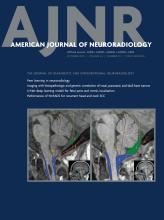Abstract
BACKGROUND AND PURPOSE: Anecdotally, postcontrast FLAIR images of vestibular schwannomas can show peritumoral hyperintense signal, hypothesized to represent gadolinium extravasation. This study assessed the incidence of this phenomenon in a cohort of patients with treatment-naïve sporadic vestibular schwannomas.
MATERIALS AND METHODS: A retrospective review of 20 patients with presumed vestibular schwannoma based on characteristic imaging findings and with dedicated internal auditory canal imaging, including postcontrast T1W1 and postcontrast FLAIR, was performed. Tumor size and location were recorded, as was the presence or absence of a fundal fluid cleft. Images were reviewed for the presence of peritumoral hyperintense signal on FLAIR images (a “halo”) and for both subjectively and objectively elevated signal in the ipsilateral cochlea and fundus.
RESULTS: Patients were randomly selected from an institutional vestibular schwannoma registry. Eleven (55.0%) were women. A peritumoral halo was present in 90% of patients, averaging 1.0 (SD, 0.2) mm in thickness. The maximum mean FLAIR signal in the ipsilateral fundus (205.9 [SD, 110.2]) was significantly greater than on the contralateral side (121.6 [SD, 27.8]) (P = .02). Maximum mean ipsilateral intracochlear signal (167.8 [SD, 104.5]) was also significantly greater than on the contralateral side (113.4 [SD, 40.1]) (P = .04).
CONCLUSIONS: A peritumoral halo on postcontrast FLAIR images was present in 90% of our cohort with randomly selected, treatment-naïve sporadic vestibular schwannomas. Although its mechanism is unknown, this signal is hypothesized to represent gadolinium extravasation, given an ipsilateral increased signal in the adjacent internal auditory canal fundus and cochlea.
ABBREVIATIONS:
- CPA
- cerebellopontine angle
- IAC
- internal auditory canal
- VS
- vestibular schwannoma
- © 2023 by American Journal of Neuroradiology












